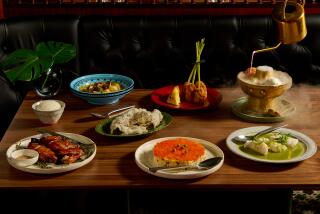Chill Out--Chill Up
- Share via
Some of the most pleasing flavor combinations, in my opinion, pair something hot and something fruity or sweet.
You may not have tried it, but watermelon with Tabasco sauce is wonderful. Sweet wine and black pepper make a delicious sauce. A reduction of orange juice with green peppercorns blended with butter is terrific with fish.
In different cuisines, many combinations of sweet or fruity flavors combine with hot peppers. North Africans make a condiment called harissa that they add to couscous and stews (tagines), often with dates and figs thrown into the stewpot. In Thai cuisine, a common spicy soup is made with coconut milk and incredibly spicy green or red curry paste.
This is a different spicing than an Indian mango chutney, in which the heat of chile pepper plays second string to the sweet mango preserve. I always add curry powder and a good dose of Tabasco to a jar of prepared chutney. Or I make my own during the summer when mangoes are in the market. In general, Indian cuisine is more murky with heat than the cuisines of Southeast Asia, where the heat is borne by a thin soup or a delicate, almost clear sauce.
In the Caribbean, where peppers are indigenous and tropical fruits are abundant, the cuisine is heavy with spicy fruit combinations. In the Western Hemisphere, hot peppers are used more in condiments and uncooked sauces, or salsas. These can range from some jalapen~os steeped in a jar of good vinegar (wine or Sherry work best) for a few weeks to a Mexican tomatillo or tomato salsa or a more modern version with papaya and lime paired to make a so-called salsa.
In the South and Southwest, heat is added mostly through marinades and barbecue sauces. Then, of course, there are the famous bean dishes called chili, appropriately enough.
So, during these dog days of summer, cook cool. Grill a steak or a piece of chicken, fish or some vegetables. Don’t heat up the house. Or cook early in the day before the heat of noon and serve a chilled or room-temperature dinner. Use one of the following fiery accompaniments to turn up the heat and cool yourself off.
MANGO CHUTNEY (VEGETARIAN; LOW-FAT COOKING)
3 mangoes, peeled, pitted and cut into 1/4-inch dice
1 small onion, finely diced
1/4 cup lemon juice
1/4 teaspoon kosher salt
3 tablespoons sugar
1 tablespoon curry powder
1 teaspoon hot pepper sauce
2 tablespoons cold-pressed peanut or salad oil
This chutney is good with white meats, poultry or shellfish.
Combine mangoes, onion, lemon juice, salt and sugar in glass or stainless steel mixing bowl. Cover and set aside at room temperature 3 hours.
Strain mango and onion mixture through strainer or colander, pressing gently to extract juice. Transfer juice to small saucepan and return mango-onion mixture to bowl.
Cook juice over low heat until liquid reduces and begins to thicken, 3 to 5 minutes. Immediately remove from heat and scrape into mixing bowl with mango mixture. Add curry powder, hot pepper sauce and oil and stir. Serve chilled or at room temperature.
2 cups. Each 2-tablespoon serving:
13 calories; 10 mg sodium; 0 cholesterol; 1 gram fat; 3 grams carbohydrates; 0 protein; 0.09 gram fiber.
PAPAYA-LIME SALSA (VEGETARIAN; LOW-FAT COOKING)
1 1/2 pounds papayas
1/4 cup oil
4 serrano chiles, slit lengthwise and seeded
1/4 cup lime juice
2 teaspoons kosher salt
2 onions, finely diced
2 bunches cilantro, stems removed, leaves finely chopped
This salsa is good with seafood and white meats.
Peel papayas and halve lengthwise. Remove seeds and discard. Chop fruit into small pieces, about size of corn kernels.
Heat oil over medium heat in medium saucepan. Add papayas, chiles, lime juice and salt. Cover and cook until papayas soften slightly, about 5 minutes. Remove from heat.
Transfer to mixing bowl. Stir in onions and cilantro. Chill completely before serving.
4 cups. Each 2-tablespoon serving:
28 calories; 149 mg sodium; 0 cholesterol; 2 grams fat; 3 grams carbohydrates; 0 protein; 0.26 gram fiber.
veg&less; than 30 minute icons:
HARISSA (Moroccan Red Pepper Paste), (VEGETARIAN)
This spicy mixture is a good accompaniment to poultry, lamb and vegetables.
1/4 cup red pepper flakes
1 tablespoon tomato paste
2 teaspoons cumin
1 teaspoon coriander
1 teaspoon salt
1/4 cup olive oil
1/2 cup water
Combine red pepper flakes, tomato paste, cumin, coriander, salt, oil and water in small saucepan. Simmer, uncovered, over medium heat 10 minutes. Pour into bowl. Cover and chill before serving.
Makes 1 cup. Each 1-tablespoon serving:
36 calories; 149 mg sodium; 0 cholesterol; 4 grams fat; 1 gram carbohydrates; 0 protein; 0.38 gram fiber.
THAI CURRY COCONUT SOUP
Thai curry paste is very, very hot. If none is available, increase the number of chiles to obtain the desired heat.
2 tablespoons oil
1 onion, coarsely chopped
1 tablespoon curry powder
2 teaspoons yellow or green Thai curry paste
1 pound boneless, skinless chicken breasts, finely diced
4 cups chicken stock or canned low-sodium chicken broth
2 to 4 serrano chiles, seeded and finely diced
1 teaspoon salt
12 to 16 small mushroom caps
3 cups unsweetened coconut milk
8 snow peas, slivered lengthwise
4 sprigs cilantro, leaves only
Heat oil in soup pot over medium heat. Add onion and saute about 2 minutes. Add curry powder, curry paste and chicken and cook 2 minutes longer.
Add chicken stock, chiles, salt and mushrooms. Increase heat to high. Cover, bring to boil and cook 2 minutes longer. Remove from heat. Add coconut milk, snow peas and cilantro. Serve immediately.
4 servings. Each serving:
542 calories; 1,489 mg sodium; 50 mg cholesterol; 46 grams fat; 9 grams carbohydrates; 29 grams protein; 3.98 grams fiber.


